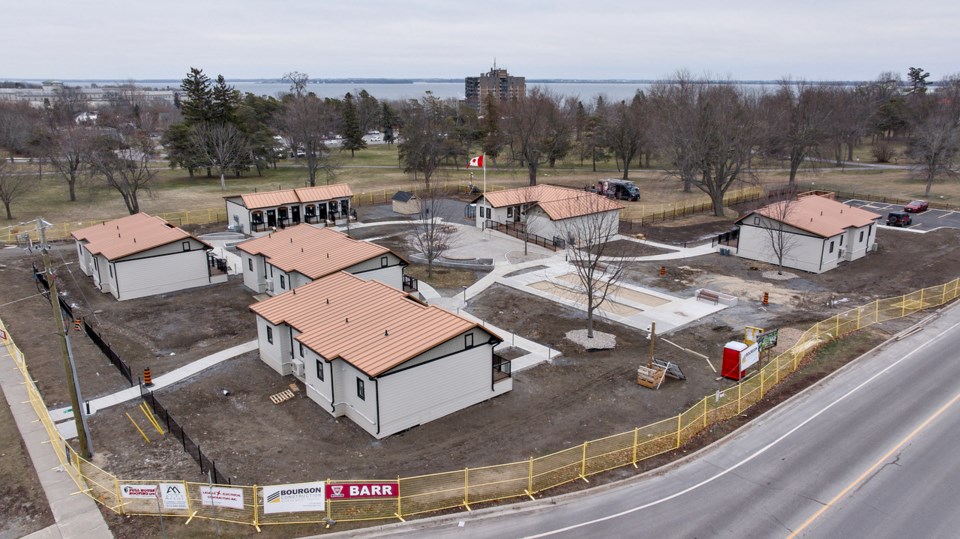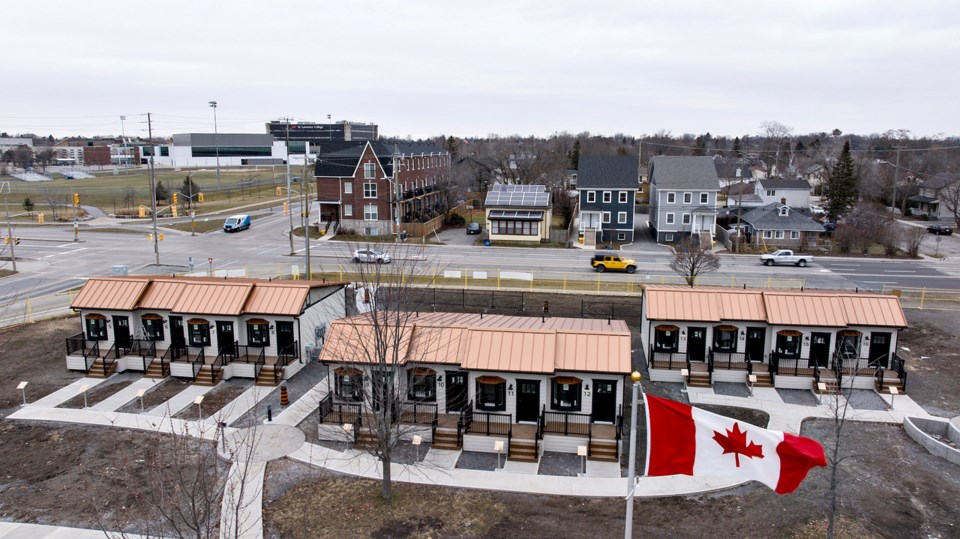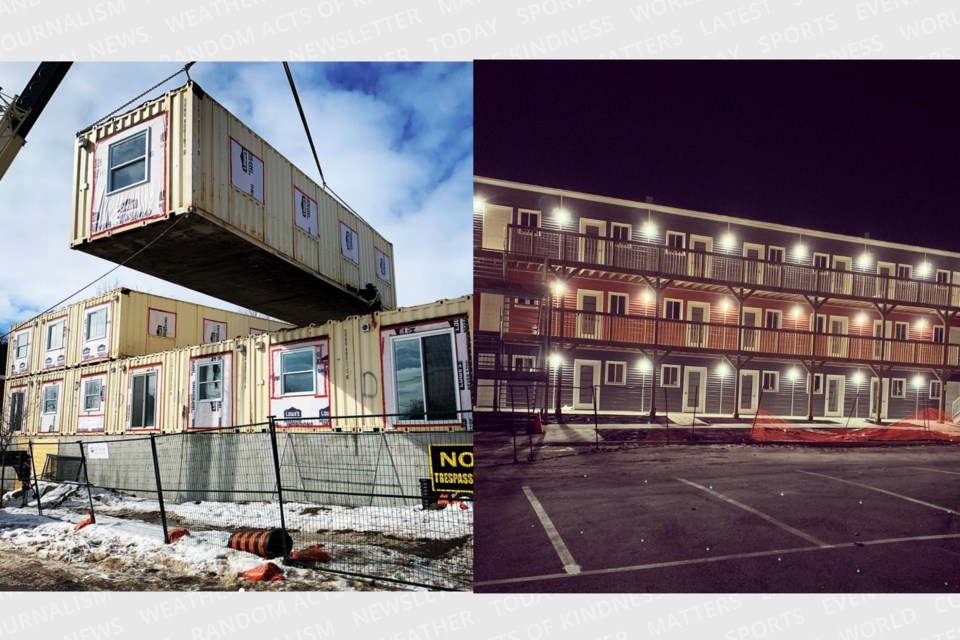Finding solutions to address the region’s housing crisis is going to require an all-hands-on-deck mentality and the ability to think outside the traditional stick frame box of most construction methods in the county, says one local official.
Steve Marshall, owner of Barrie-based Northern Shield Development Corporation — which recently completed a project constructing a tiny homes community in Kingston for veterans at risk of homelessness through the Homes For Heroes Foundation — believes there are a variety of unique housing ideas around the globe that could be used in Simcoe County. (The county is responsible for social housing locally.)
But he says they’re just not typically being considered.
“The problem is, there are a lot of solutions right in front of everybody, but they just don’t look at them. They quickly breeze over them for other reasons,” Marshall said. “From a straight simplicity standpoint, we have a major supply-and-demand mismatch. The demand is through the ceiling and the supply is barely existent.
"And then the cost to construct everything is through the ceiling, (so) the cost of construction has surpassed people’s ability to pay for it," he added.
The company has also constructed a three-storey shipping container apartment complex on Elgin Street in Orillia, and has been touting the benefit of these types of “non-traditional” style of construction to help ease some of the pressure on the housing crisis for a number of years.
“Shipping containers are one of many. They’re not a silver bullet, but it’s an option. We are using something that already exists. One of the main reasons we were able to do the Elgin Street apartment project at the price point we did is … we didn’t have to build it from scratch," Marshall said. "Repurposing things that exist out there is a way to make sense of some level of housing."
He says it’s important for governments and developers to create “need-based” housing.
“Not everybody needs a 2,500-square-foot house. If we predetermine what housing has to be for Canadians, then we are supposing that everybody can afford that," Marshall said. "Somebody who is at the risk of homelessness, or is homeless, clearly can’t afford $2,500 a month for rent. It’s impossible.
"If we never allow the bar to be set at a level that’s attainable for somebody, how would we ever be able to expect to provide housing for all the people that need it?”
He pointed to the concept of micro-housing, or micro-communities, as one potential idea.
“Use the concept and the power of community. There’s a unique way of doing something. Harness what’s there. Create these smaller-type communities," Marshall said.
"Europe and lots of other places have done it, but I am not aware of anywhere in Canada that’s done it," he added. "If you created modified versions of subdivisions in a much more scaled-down capacity, there’s people that are begging for that … but we don’t have provisions that provide for that.”
Micro-housing is an idea that could make a significant impact in the local housing crisis, Marshall says.
“The idea of everyone owning a 2,500-sq.-ft. home is fleeting. People can’t afford the cost of that. Nobody is building war-time houses or starter homes," he said. "There is a 'tiny home' movement, and tiny homes and tiny home villages need to be on the list of considerations. We should make provisions for people who want to live that way.”

Another concept Marshall says needs to be explored is the idea of land leasing.
“Don’t force people, developers or investors to have to buy the land in order to be able to provide housing on that land," he said. "Here in Barrie, they’ve proven that.
"They've got a temporary homelessness facility where they brought in a (structure) and put it on a piece of property as a temporary solution for a problem. It still serves the purpose of putting a roof over someone’s head, but at a significantly reduced cost.”
Not having to purchase land immediately opens up additional opportunities to make something work financially, Marshall says.
One thing he believes is often overlooked as a potential idea is the use of mobile home parks, which offer people a safe roof over their heads and with less cost compared to a typical home in Ontario. Not only are they significantly smaller, but they are not required to meet all aspects of the Ontario Building Code, which Marshall says adds significantly to the price tag of any building project.
“There are still people who are still living full time in mobile home parks. They’re still safe and warm, but the level of accommodation that mobile home parks allow is at a far reduced cost than forcing people to live in a townhome or the cost of multi-residential construction,” he added.
Unfortunately, most areas are not zoned for mobile home-style neighbourhoods, a factor Marshall says is one of the key barriers to cost-effective construction.
“Immediately, someone says (something) is not zoned properly … so they can’t do it. I am the guy that says, ‘hold on. Why can’t we?’ If we can do something in an area and do it under a special zoning provision … and that would allow something to occur (that we are) desperately in need of, why would that be the one that would be the impossible task to change?”
That’s where he says creativity and flexibility by those who govern the how and where homes can be built is key to beginning to address the issue.
“The one thing that frustrates the building community and people like me in trying to develop housing and get homes — whether it’s affordable or otherwise — is the feeling and the perception that we are always working in an adversarial relationship with the municipality in trying to battle for development,” Marshall said.
“We all recognize, because we say it every day, but if we are truly in a crisis, shouldn’t the attitude that occurs be let’s figure out every possible way to allow this development to occur, rather than what we deal with now? Every time we go into build something, it’s like (municipalities) start with ‘it’s impossible to build’," he added. "It’s never a collaborative effort. We say we have a housing crisis, but then you go and submit a housing permit and get back a list of 175,000 questions and all these hoops you have to jump through … which add unnecessary costs to a project.”
Marshall is in the process of challenging the need for all styles of housing construction to meet what he calls the “crazy costs” associated with meeting all of the Ontario Building Code requirements.
“Whether it’s a temporary or permanent solution, whether it’s a house or an apartment … everybody is under the letter of the law of the Ontario Building Code," he said. "We are forcing everybody to fall under the same provisions, where not everybody lives the same way. I feel there should be tiers on different levels or styles of housing to match certain needs of Canadians."
Housing is in a bit of a “weird place,” said Marshall, pointing to automobile manufacturing as an example of an industry that has created a market for all types of buyers. Unfortunately, due to the Ontario Building Code, all housing projects must meet what he called "luxury model" rules.
“There are entry-level cars up to custom, premium cars. They have tried to create an entry level so someone can get a baseline car at a price point that’s far more affordable to them than someone else who wants a midline or luxury car," he said. "What we’ve done with housing is we’ve said everyone has to drive a luxury model. It makes no sense.”
Ultimately, Marshall believes the first rung on the housing market in Canada is simply too high now.
“The bottom rung the majority of Canadians can’t reach. You’ve got to create these rungs if you ever want to break the cycle on housing," he said. "Bring the rungs down so people have the opportunity to be able to climb. We’ve taken out the economical style of housing which sadly now affects more than half of our population.
“The reality is there are a whole bunch of options available, but for some reason or another get shut down. The right thing and the good idea is prevented by a bad policy," Marshall added. "People are trying to do good things — there are glimmers of it. You can see the good ideas coming through, but that’s the part that needs to be expanded on. The secret to this is to further the conversation about how we can allow what we know needs to be built to get built.”
Brad Spiewak, the County of Simcoe’s director of social housing, acknowledges that housing is a “very complicated problem” and, unfortunately, there is not one simple solution.
“It takes quite a number of solutions to help relieve the pressure that’s being put on the system,” he said. “A lot of it also comes down to who are you trying to house? What are the demographics? What’s the length of stay and what’s the type of housing you're trying to create?”
Spiewak said the county has traditional brick-and-mortar construction which, while that is suitable for long stays and aging in place, it doesn’t address all of the pressing needs in the community.
Tiny homes have proven successful in several municipalities, he added, but are not typically used for long-term affordable housing options. More often, that option would be used for shelter relief or supportive housing, Spiewak said.
“A lot of the tiny homes, the sleeping area is the loft and if you’re a senior … to have them climb down the ladder to use the washroom at night doesn’t work,” he said. “When it comes to modular, it’s been around a long time, but maybe some of the uses of it are becoming a bit more new.”
Permanent modulars — also known as factory-built modulars that are then assembled on a permanent foundation and stacked up to become a multi-storey building — is something the county has already utilized.
“We have one of those, which we opened about two years ago in Barrie (and) which has worked very well. It’s very cost-effective,” said Spiewak, adding the county has also recently utilized a portable modular system in Orillia.
Not only can portable modulars be located anywhere, they’re also easier to transport; they can be taken apart and moved to a different location, he said.
“Something like that, there are certain advantages. From a county perspective, we have one in Barrie and Orillia on West Street, and a third one that’s going into Collingwood that will be delivered and set up at the end of June , beginning of July," Spiewak said. "They can make a lot of sense for smaller buildings and they make a whole lot of sense with a compressed construction timeline, as they’re built in a warehouse, the weather doesn’t become an issue.”
Typically with a construction job they would lose between two to four months due to weather, Spiewak said.

“You remove all of that when built in a climate-controlled warehouse. That might be another thing that dictates (decisions) when you’re choosing what solutions work. Certainly, from a timing point of view, modular is going to be very quick," he added.
Spiewak told BarrieToday he is aware of projects in Halifax and Waterloo that are used to address the homelessness issue in those areas. He described them as being similar to a prefabricated shed which, although modest, have heat, space for a bed and a table and a communal area that includes showers and washrooms.
“We are doing some of those. If you’re talking immediate need for shelter, some of those small ones do work well. The question always is, we’ve got this person off the street and in a shelter, but now what? They can’t live in that temporary shelter forever," he said.
"So where do they go next? Socially, as a society, we need to move people from homelessness into supportive and maybe assisted and then independent living. Financially, as a society and as a taxpayer it makes sense as well," Spiewak added.
Modular communities, of which there are already a few within the county, are another option that Spiewak has seen work well.
“It’s not a trailer park. It’s a fairly affordable, independent living scenario, whether that be seniors or young families, because unlike an apartment building they have a bit of yard… and the cost is less than a house. There are different operating models for that … and that is one at the county we’ve been approached about a few times and that has piqued our interest,” he said.
Ultimately, for any municipality or community to be successful and thrive there has to be room for your workforce to live. If that doesn’t exist, said Spiewak, they won’t be able to attract employers to locate in the area. It also means existing employers will have a hard time attracting employees if there’s no place to live.
“Even around the county, some of the larger employers, and seasonal employers, are having a really difficult time," he said. "If they can’t have staff that’s going to affect their ability to make a profit. In order to grow and have a sustainable workforce and a good employment base, employees have to live somewhere.”
On the social side, Spiewak said if you don’t have places for people to live then that will in turn create a homelessness issues, mental health and addiction issues will worsen, and the health-care and criminal justice systems will see the fallout when adequate and safe housing doesn’t exist.
“As a municipality, if you’re not looking outside the box at all of these things, it’s going to to contribute to all these other social and economic problems that are going to be a burden to that municipality,” he said.
“It’s such a huge problem that has been many years in the making that it’s going to take the co-operation of not just the county but municipalities, not-for-profits, developers … it’s a problem that is going to need everybody’s help to find the solutions.”
